2017 FORD F SERIES MOTORHOME AND COMMERCIAL CHASSIS coolant level
[x] Cancel search: coolant levelPage 100 of 164
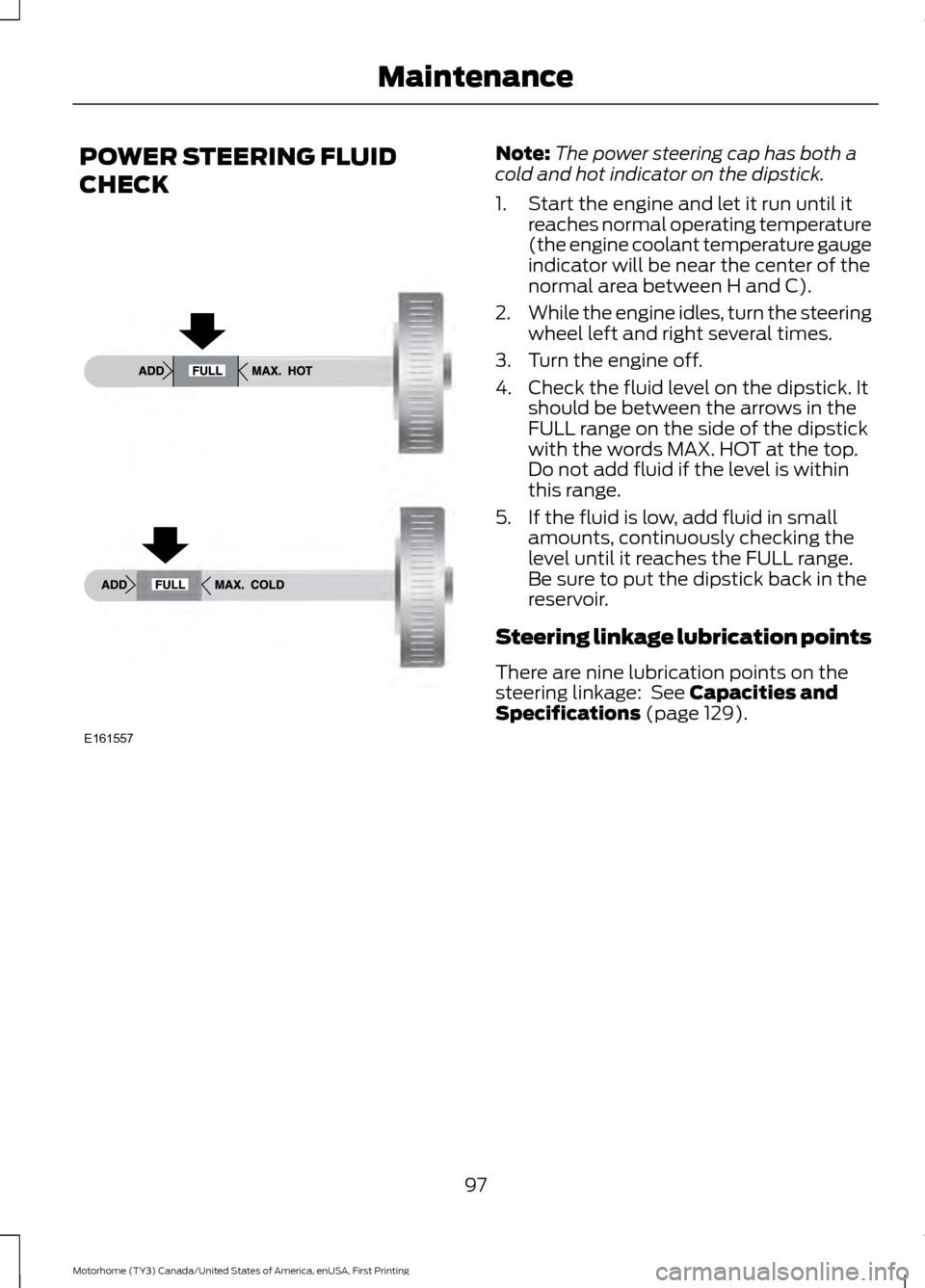
POWER STEERING FLUID
CHECK Note:
The power steering cap has both a
cold and hot indicator on the dipstick.
1. Start the engine and let it run until it reaches normal operating temperature
(the engine coolant temperature gauge
indicator will be near the center of the
normal area between H and C).
2. While the engine idles, turn the steering
wheel left and right several times.
3. Turn the engine off.
4. Check the fluid level on the dipstick. It should be between the arrows in the
FULL range on the side of the dipstick
with the words MAX. HOT at the top.
Do not add fluid if the level is within
this range.
5. If the fluid is low, add fluid in small amounts, continuously checking the
level until it reaches the FULL range.
Be sure to put the dipstick back in the
reservoir.
Steering linkage lubrication points
There are nine lubrication points on the
steering linkage: See Capacities and
Specifications (page 129).
97
Motorhome (TY3) Canada/United States of America, enUSA, First Printing MaintenanceE161557
Page 106 of 164
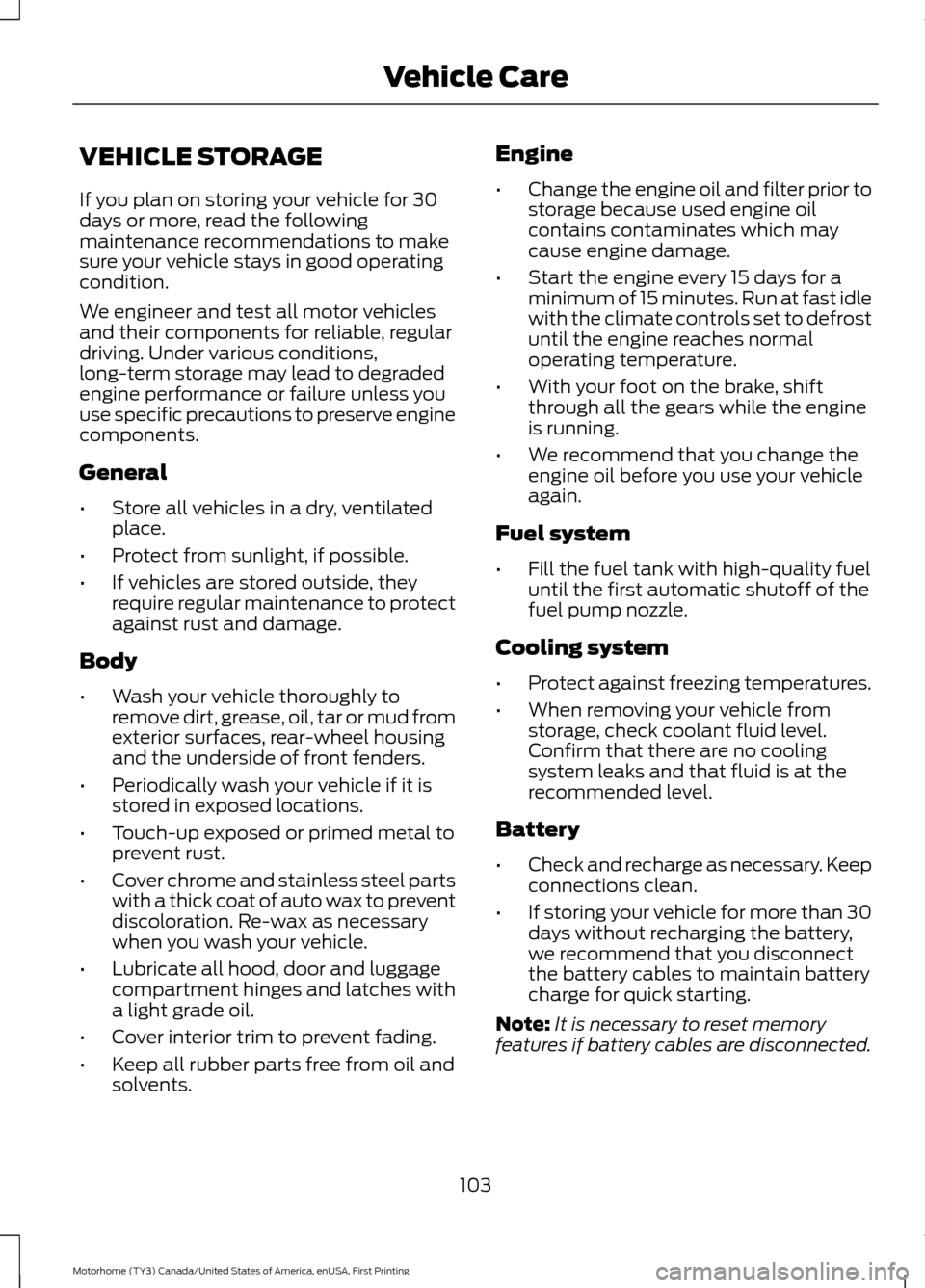
VEHICLE STORAGE
If you plan on storing your vehicle for 30
days or more, read the following
maintenance recommendations to make
sure your vehicle stays in good operating
condition.
We engineer and test all motor vehicles
and their components for reliable, regular
driving. Under various conditions,
long-term storage may lead to degraded
engine performance or failure unless you
use specific precautions to preserve engine
components.
General
•
Store all vehicles in a dry, ventilated
place.
• Protect from sunlight, if possible.
• If vehicles are stored outside, they
require regular maintenance to protect
against rust and damage.
Body
• Wash your vehicle thoroughly to
remove dirt, grease, oil, tar or mud from
exterior surfaces, rear-wheel housing
and the underside of front fenders.
• Periodically wash your vehicle if it is
stored in exposed locations.
• Touch-up exposed or primed metal to
prevent rust.
• Cover chrome and stainless steel parts
with a thick coat of auto wax to prevent
discoloration. Re-wax as necessary
when you wash your vehicle.
• Lubricate all hood, door and luggage
compartment hinges and latches with
a light grade oil.
• Cover interior trim to prevent fading.
• Keep all rubber parts free from oil and
solvents. Engine
•
Change the engine oil and filter prior to
storage because used engine oil
contains contaminates which may
cause engine damage.
• Start the engine every 15 days for a
minimum of 15 minutes. Run at fast idle
with the climate controls set to defrost
until the engine reaches normal
operating temperature.
• With your foot on the brake, shift
through all the gears while the engine
is running.
• We recommend that you change the
engine oil before you use your vehicle
again.
Fuel system
• Fill the fuel tank with high-quality fuel
until the first automatic shutoff of the
fuel pump nozzle.
Cooling system
• Protect against freezing temperatures.
• When removing your vehicle from
storage, check coolant fluid level.
Confirm that there are no cooling
system leaks and that fluid is at the
recommended level.
Battery
• Check and recharge as necessary. Keep
connections clean.
• If storing your vehicle for more than 30
days without recharging the battery,
we recommend that you disconnect
the battery cables to maintain battery
charge for quick starting.
Note: It is necessary to reset memory
features if battery cables are disconnected.
103
Motorhome (TY3) Canada/United States of America, enUSA, First Printing Vehicle Care
Page 107 of 164
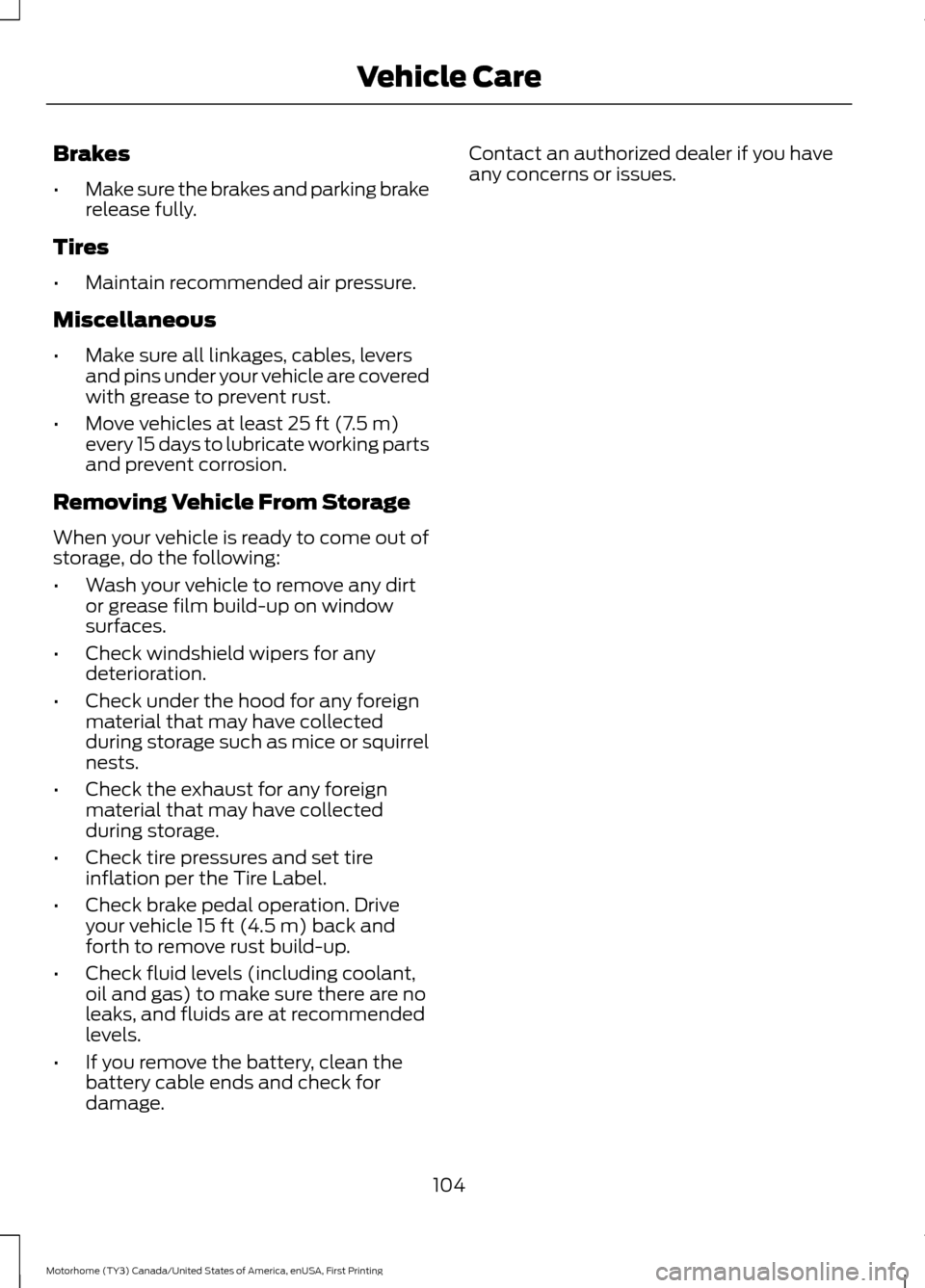
Brakes
•
Make sure the brakes and parking brake
release fully.
Tires
• Maintain recommended air pressure.
Miscellaneous
• Make sure all linkages, cables, levers
and pins under your vehicle are covered
with grease to prevent rust.
• Move vehicles at least 25 ft (7.5 m)
every 15 days to lubricate working parts
and prevent corrosion.
Removing Vehicle From Storage
When your vehicle is ready to come out of
storage, do the following:
• Wash your vehicle to remove any dirt
or grease film build-up on window
surfaces.
• Check windshield wipers for any
deterioration.
• Check under the hood for any foreign
material that may have collected
during storage such as mice or squirrel
nests.
• Check the exhaust for any foreign
material that may have collected
during storage.
• Check tire pressures and set tire
inflation per the Tire Label.
• Check brake pedal operation. Drive
your vehicle
15 ft (4.5 m) back and
forth to remove rust build-up.
• Check fluid levels (including coolant,
oil and gas) to make sure there are no
leaks, and fluids are at recommended
levels.
• If you remove the battery, clean the
battery cable ends and check for
damage. Contact an authorized dealer if you have
any concerns or issues.
104
Motorhome (TY3) Canada/United States of America, enUSA, First Printing Vehicle Care
Page 140 of 164
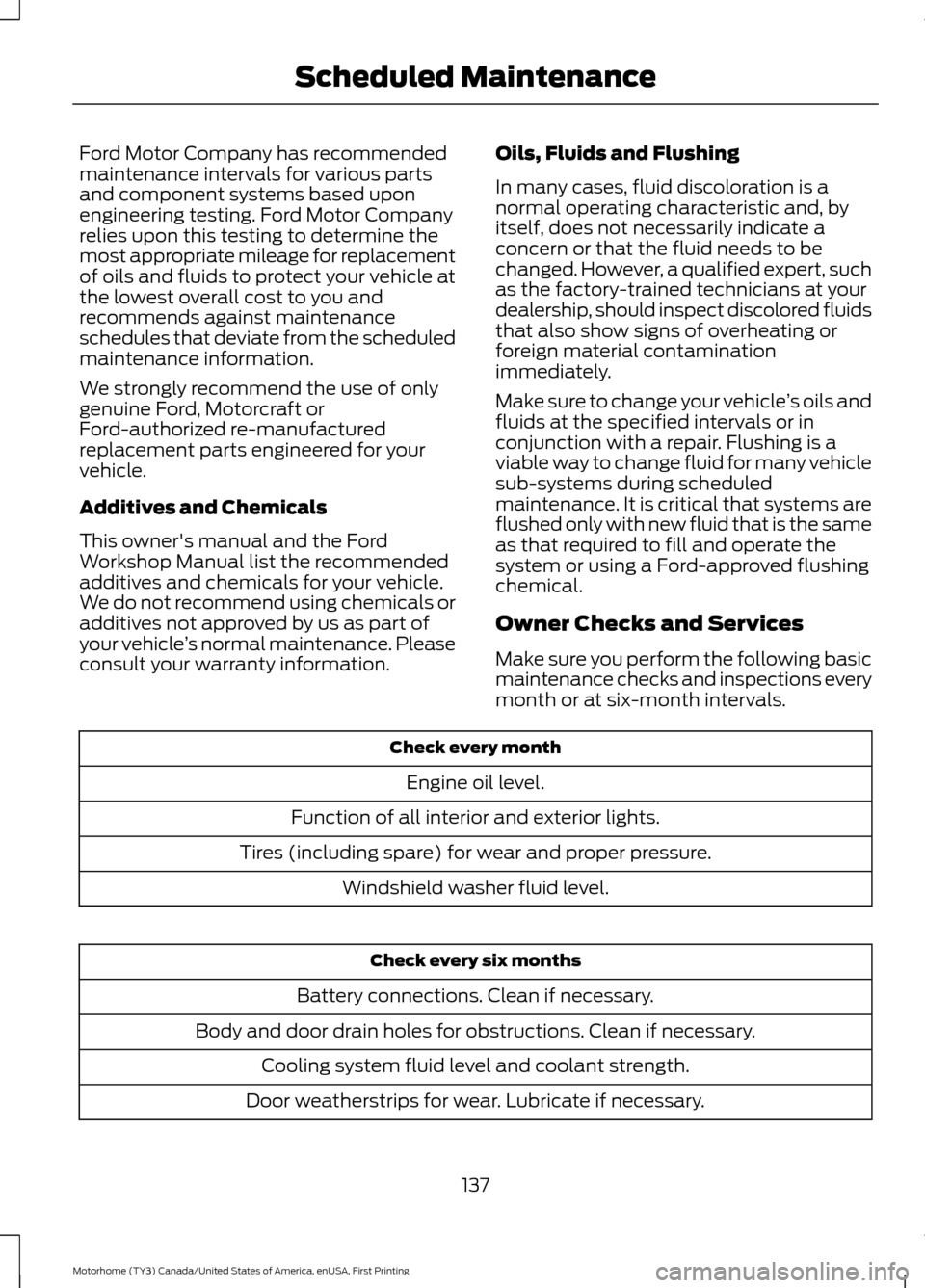
Ford Motor Company has recommended
maintenance intervals for various parts
and component systems based upon
engineering testing. Ford Motor Company
relies upon this testing to determine the
most appropriate mileage for replacement
of oils and fluids to protect your vehicle at
the lowest overall cost to you and
recommends against maintenance
schedules that deviate from the scheduled
maintenance information.
We strongly recommend the use of only
genuine Ford, Motorcraft or
Ford-authorized re-manufactured
replacement parts engineered for your
vehicle.
Additives and Chemicals
This owner's manual and the Ford
Workshop Manual list the recommended
additives and chemicals for your vehicle.
We do not recommend using chemicals or
additives not approved by us as part of
your vehicle
’s normal maintenance. Please
consult your warranty information. Oils, Fluids and Flushing
In many cases, fluid discoloration is a
normal operating characteristic and, by
itself, does not necessarily indicate a
concern or that the fluid needs to be
changed. However, a qualified expert, such
as the factory-trained technicians at your
dealership, should inspect discolored fluids
that also show signs of overheating or
foreign material contamination
immediately.
Make sure to change your vehicle
’s oils and
fluids at the specified intervals or in
conjunction with a repair. Flushing is a
viable way to change fluid for many vehicle
sub-systems during scheduled
maintenance. It is critical that systems are
flushed only with new fluid that is the same
as that required to fill and operate the
system or using a Ford-approved flushing
chemical.
Owner Checks and Services
Make sure you perform the following basic
maintenance checks and inspections every
month or at six-month intervals. Check every month
Engine oil level.
Function of all interior and exterior lights.
Tires (including spare) for wear and proper pressure. Windshield washer fluid level. Check every six months
Battery connections. Clean if necessary.
Body and door drain holes for obstructions. Clean if necessary. Cooling system fluid level and coolant strength.
Door weatherstrips for wear. Lubricate if necessary.
137
Motorhome (TY3) Canada/United States of America, enUSA, First Printing Scheduled Maintenance
Page 141 of 164
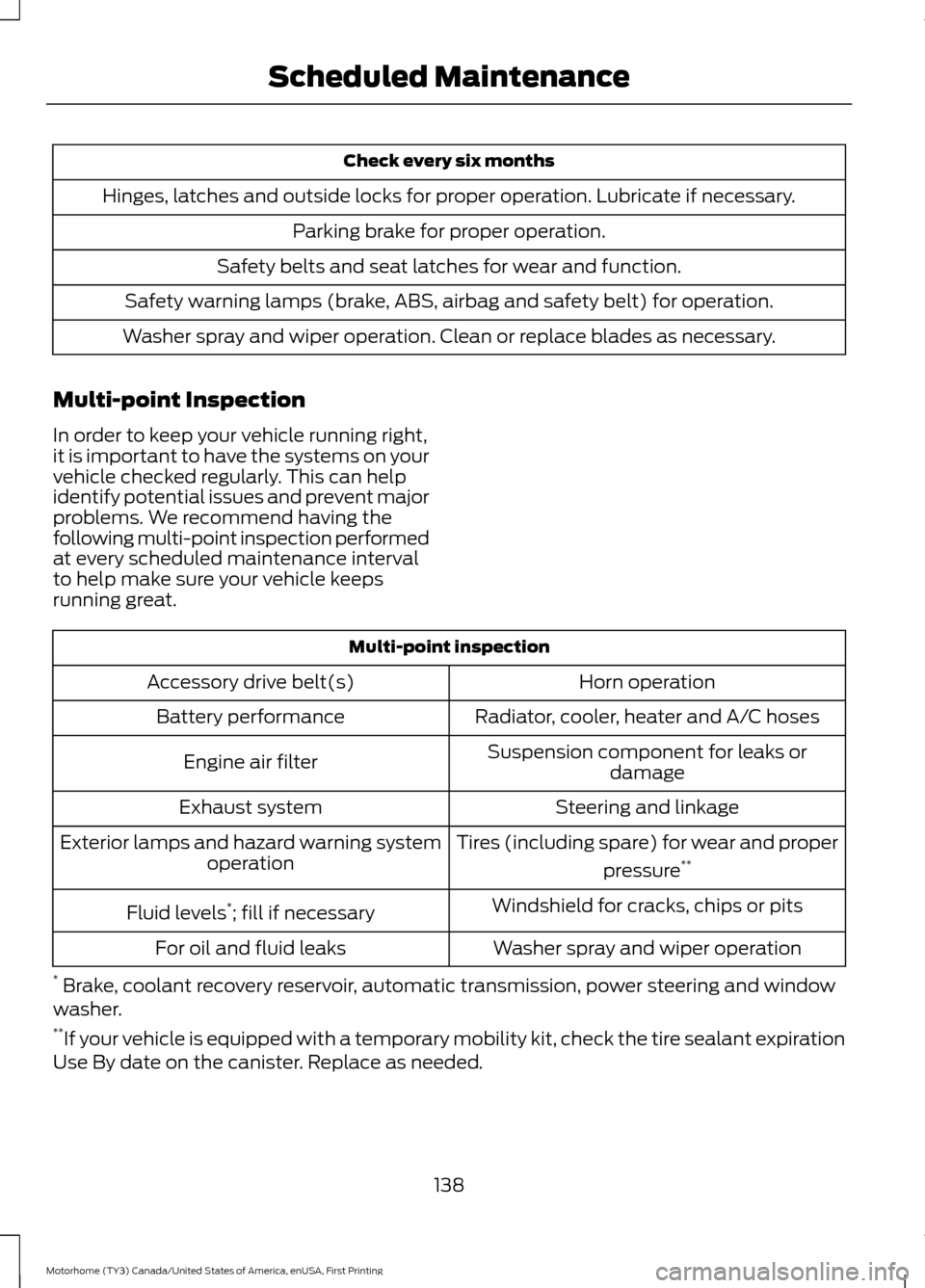
Check every six months
Hinges, latches and outside locks for proper operation. Lubricate if necessary. Parking brake for proper operation.
Safety belts and seat latches for wear and function.
Safety warning lamps (brake, ABS, airbag and safety belt) for operation.
Washer spray and wiper operation. Clean or replace blades as necessary.
Multi-point Inspection
In order to keep your vehicle running right,
it is important to have the systems on your
vehicle checked regularly. This can help
identify potential issues and prevent major
problems. We recommend having the
following multi-point inspection performed
at every scheduled maintenance interval
to help make sure your vehicle keeps
running great. Multi-point inspection
Horn operation
Accessory drive belt(s)
Radiator, cooler, heater and A/C hoses
Battery performance
Suspension component for leaks ordamage
Engine air filter
Steering and linkage
Exhaust system
Tires (including spare) for wear and properpressure**
Exterior lamps and hazard warning system
operation
Windshield for cracks, chips or pits
Fluid levels *
; fill if necessary
Washer spray and wiper operation
For oil and fluid leaks
* Brake, coolant recovery reservoir, automatic transmission, power steering and window
washer.
** If your vehicle is equipped with a temporary mobility kit, check the tire sealant expiration
Use By date on the canister. Replace as needed.
138
Motorhome (TY3) Canada/United States of America, enUSA, First Printing Scheduled Maintenance
Page 160 of 164
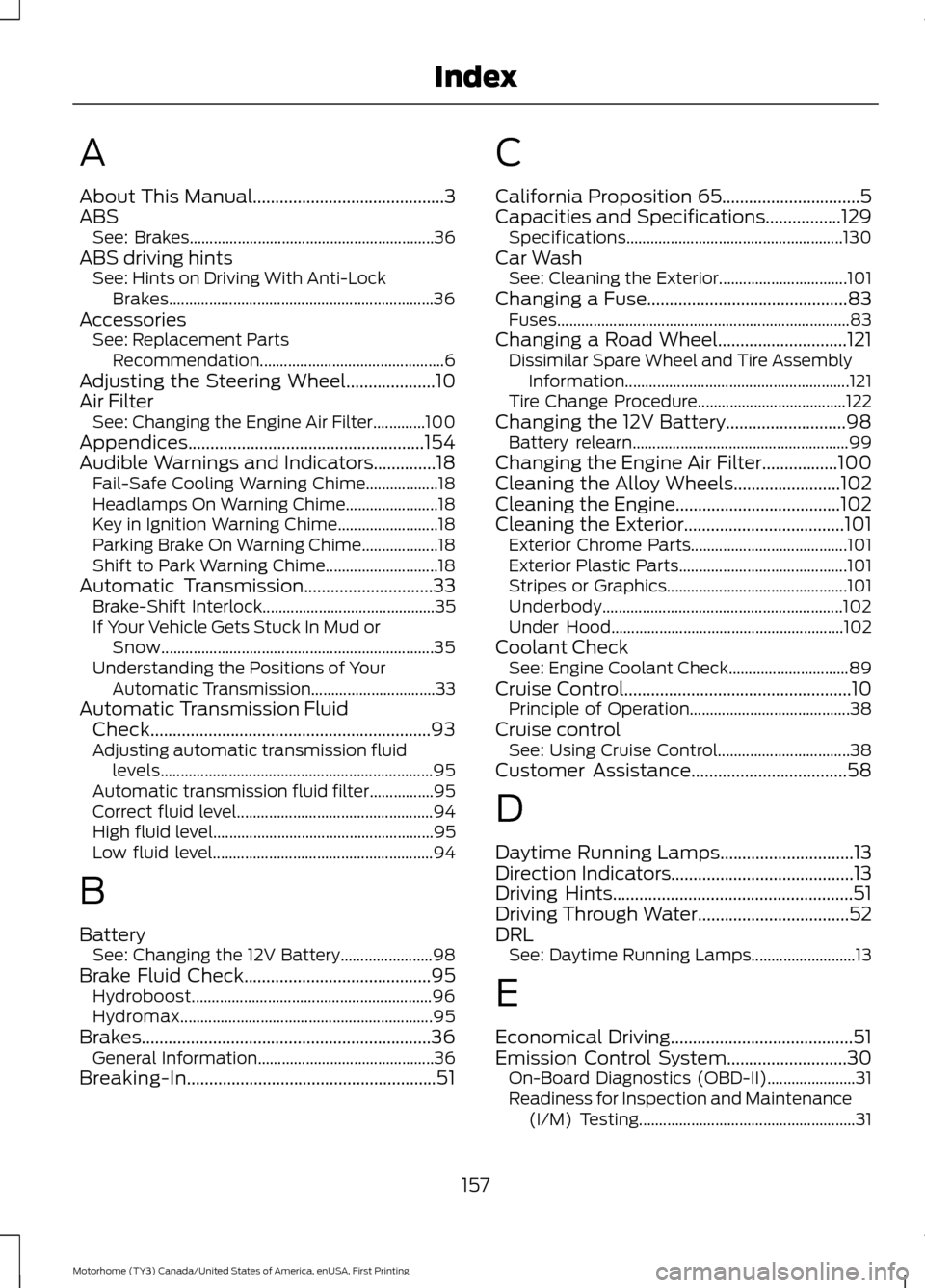
A
About This Manual...........................................3
ABS See: Brakes............................................................. 36
ABS driving hints See: Hints on Driving With Anti-Lock
Brakes.................................................................. 36
Accessories See: Replacement Parts
Recommendation.............................................. 6
Adjusting the Steering Wheel
....................10
Air Filter See: Changing the Engine Air Filter.............100
Appendices.....................................................154
Audible Warnings and Indicators
..............18
Fail-Safe Cooling Warning Chime.................. 18
Headlamps On Warning Chime....................... 18
Key in Ignition Warning Chime......................... 18
Parking Brake On Warning Chime................... 18
Shift to Park Warning Chime............................ 18
Automatic Transmission.............................33 Brake-Shift Interlock........................................... 35
If Your Vehicle Gets Stuck In Mud or Snow.................................................................... 35
Understanding the Positions of Your Automatic Transmission............................... 33
Automatic Transmission Fluid Check...............................................................93
Adjusting automatic transmission fluid levels.................................................................... 95
Automatic transmission fluid filter................95
Correct fluid level................................................. 94
High fluid level....................................................... 95
Low fluid level....................................................... 94
B
Battery See: Changing the 12V Battery....................... 98
Brake Fluid Check
..........................................95
Hydroboost............................................................ 96
Hydromax............................................................... 95
Brakes.................................................................36 General Information............................................ 36
Breaking-In........................................................51 C
California Proposition 65
...............................5
Capacities and Specifications.................129 Specifications...................................................... 130
Car Wash See: Cleaning the Exterior................................ 101
Changing a Fuse
.............................................83
Fuses........................................................................\
. 83
Changing a Road Wheel
.............................121
Dissimilar Spare Wheel and Tire Assembly
Information........................................................ 121
Tire Change Procedure..................................... 122
Changing the 12V Battery...........................98 Battery relearn...................................................... 99
Changing the Engine Air Filter.................100
Cleaning the Alloy Wheels
........................102
Cleaning the Engine.....................................102
Cleaning the Exterior....................................101 Exterior Chrome Parts....................................... 101
Exterior Plastic Parts.......................................... 101
Stripes or Graphics............................................. 101
Underbody............................................................ 102
Under Hood.......................................................... 102
Coolant Check See: Engine Coolant Check.............................. 89
Cruise Control
...................................................10
Principle of Operation........................................ 38
Cruise control See: Using Cruise Control................................. 38
Customer Assistance
...................................58
D
Daytime Running Lamps
..............................13
Direction Indicators.........................................13
Driving Hints......................................................51
Driving Through Water
..................................52
DRL See: Daytime Running Lamps.......................... 13
E
Economical Driving
.........................................51
Emission Control System...........................30
On-Board Diagnostics (OBD-II)...................... 31
Readiness for Inspection and Maintenance (I/M) Testing...................................................... 31
157
Motorhome (TY3) Canada/United States of America, enUSA, First Printing Index